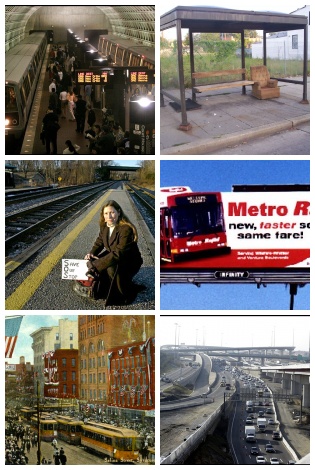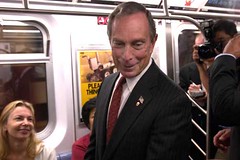More on Metro and rethinking transit marketing
Oddly enough, Dan Tangherlini was in line ahead of me at Starbucks, so I was likely the first person to congratulate him today. Not being a "real journalist" I wasn't up to grilling him about his intentions. And I didn't have my camera with me either...
But in the vein of the "may you live in interesting times" Chinese blessing/curse, I did hand him the Examiner and pointed out today's Sprawl and Crawl column, written before Richard White's resignation, about the difficulty of the job, that by and large White has done a decent job, and over-involvement of the Board of Directors in day-to-day operations.
It does make me further think about my "dream" of re-writing (or producing a new version) of the textbook Marketing Public Transit, perhaps with these images on the cover:

Mosaic created with FD's Flickr Toys.
One of the ways I would structure the text is along the lines of the input, throughput, and output publics framework laid out by Armand Lauffer in his textbook Marketing for Not-For-Profit Organizations. I discussed this in a previous blog entry, "Making Transit Sexy."
Transit marketing must be reconceptualized along the lines of this framework.
One problem with WMATA, and these problems start at the top, is a tin ear in terms of listening and relating to the public. They need to rethink their public communications efforts, and develop different kinds of campaigns according to the type of public they are attempting to reach.
Anyone who took expository writing in school remembers those lessons about "defining your audience." The one problem with those classes is we didn't learn about how to categorize audiences more specifically. For nonprofit and government organizations, Lauffer's work is particularly useful in this regard.

Like Mayor Bloomberg, Dan Tangherlini rides public transportation.
Richard White didn't have much of a public persona, although he dealt mostly with high-level businesspeople and other government public officials. Since elected officials comprise a majority of the WMATA Board, and they are responsible, nominally, to the public, even appointed officials in high-profile government agencies perhaps need to consider how "public communications" activities are an increasingly important part of their job... if they want to keep their job (on the other hand, look what happened to David Gunn of Amtrak...).
At the same time, marketing isn't really about "selling" only what you want to sell. It is about responding to the market(s) and segments, leading market(s), and often balancing conflicting objectives (such as elected officials that want to keep taxes low, citizens who want more transit, and operations personnel who are looking for more financial support to maintain deteriorating infrastructure).
Public transportation systems have to sell use as well as funding, since farebox revenue only covers a portion of current operations, and nothing towards expansion (and WMATA is the number one transit system in the U.S. in the percentage of farebox revenue collected). Funding has to be sold to non-users as well as users, and of course, to public officials.
It's a tough job in any community, particularly this one, as Steve Eldridge, the Sprawl and Crawl columnist for the Examiner, so rightly pointed out in today's column.
Labels: strategic communications and marketing, transit, transit management



0 Comments:
Post a Comment
<< Home